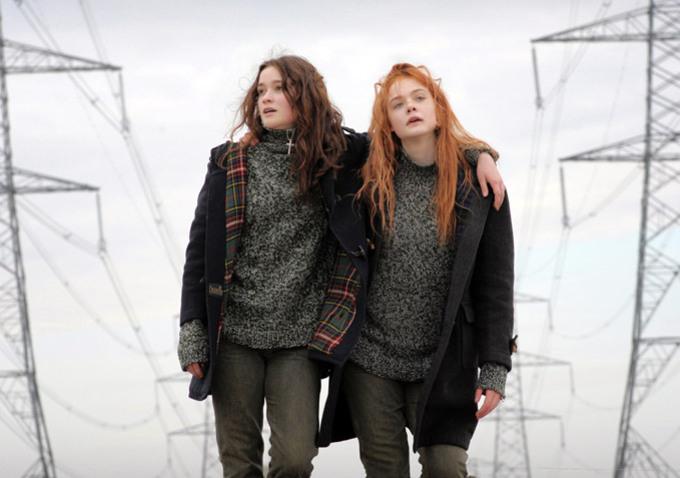Director: Sally Potter
Starring: Elle Fanning, Alice Englert, Allessandro Nivola, Christina Hendricks, Timothy Spall, Oliver Platt, Annette Bening
UK Release date: 19 October 2012
Certificate: 12A (89 mins)
Philip Larkin famously placed the birth of the swinging sixties in ‘nineteen sixty-three … between the end of the Chatterley ban / and the Beatles’ first LP.’ Sally Potter’s film, Ginger & Rosa is set one year before this, in a Britain still stuck culturally in the austere fifties – a colourless, Cold War era of Brylcreem and saloon bars, duffel coats and Aldermarston marches. The film opens with old grainy footage of an atomic test explosion, followed by a short camera pan across the rubble of Hiroshima. These images cast a pall over the rest of the story.
Born in 1945 in the same London maternity ward, Ginger and Rosa are two seventeen-year-old schoolgirls, played respectively by an American (Elle Fanning) and an Australian (newcomer Alice Englert.) Since both girls have completely authentic English accents, one must applaud the skills of their dialogue coach. Incredibly, Elle Fanning (younger sister of Dakota Fanning) was only thirteen when the film was made. Her performance is remarkable.
Ginger and Rosa are best friends, in the intense way that only adolescent girls can be. They dress identically in a beatnik way (unkempt hair, rollneck sweaters, duffel coats) and do everything together, like ironing each other’s hair, or sharing a bath to break in their shrink-to-fit blue jeans. Apart from their hair colour (Ginger is very ginger), they could be twins. But of course the girls are individuals.
Rosa is sexually more mature and has a greater confidence with boys. Her father walked out when she was young, an incident that may have something to do with her recklessness in having fleeting relationships with complete strangers. Ginger on the other hand prefers books to boys; she reads Simone de Beauvoir and wants to be T.S Eliot. Her left-leaning parents (played by Alessandro Nivola and Christina Hendricks) are bohemians whose radical friends (Timothy Spall, Oliver Platt and Annette Bening) encourage young Ginger to be politically active.
Inspired by all the talk at home of Bertrand Russell and nuclear disarmament, Ginger takes Rosa along to a YCND meeting (the Y is for ‘youth’) where they quickly learn about nuclear annihilation and The Bomb. The girls are understandably terrified.
Rosa’s immediate response is to seek solace at church. Huddled in a dark empty pew, she gives Ginger a pink plastic rosary and tells her to pray. Ginger finds the rosary exotic but she has no idea what to do with it. Walking into a dinner party at home with the rosary worn as a necklace, Ginger is steered carefully by the adults from any further infection by the God delusion. But despite their attempts at reassurance, the girl’s fears of annihilation increase.
Ginger’s father, Roland (always ‘Roland’, never ‘Dad’) is a politics lecturer who is quite unapologetic about the carefree relationships he has with his students. He is a bit like Howard Kirk in Malcolm Bradbury’s The History Man, only without the laughs. After an argument with Ginger’s frustrated-artist mother, Natalie, Roland moves out of the family home. Ginger then starts to argue with her mother and moves into a very grotty attic room at her father’s new address. As the girls start to hang out at Roland’s pad the inevitable happens and Roland seduces Rosa. Ginger is naturally traumatised.
Her father justifies his behaviour by implying that, as a conscientious objector who has done time in prison, he has somehow earned his bohemian lifestyle and will no longer be fettered by bourgeois morality. While this might have been an unusual attitude for 1962, there will be many more men (though perhaps rather fewer women) in the decade to come who will applaud such behaviour as liberating, as part of the counter-cultural revolution. Like Bradbury’s history man, many lecturers in the 1960s and 1970s will not worry themselves unduly over bourgeois notions like professional ethics. Age is surely just a number.
That Britain is currently coming to terms with the legacy of that sexual revolution (viz the current self-examination at the BBC) gives the film a very palpable topicality.
If the film isn't wonderfully written, it is well directed. There is much to admire in Sally Potter’s mise en scène, an example being the way car drivers are offscreen when the girls hitch on the road - a reminder that hitching was once so ubiquitous that hitchers weren’t expected to make conversation. Robbie Ryan’s cinematography is excellent, and the camerawork generally matches the girls’ moods (hand-held when they’re excitable; locked-off when they’ve calmed down.) But occasionally the blocking of the actors feels problematic. In the climactic argument scene when everyone’s secrets spill out, the actors seem squashed against the walls of the room and into the doorway. Perhaps Potter could have found a larger room.
The film’s design by Carlos Conti and Andea Matheson is grubby but well chosen and expressive. Ginger’s attic bedroom at her father's place could be the set of Steptoe and Son, while the city outside resembles a permanent bomb-site. Potter’s London is, however, curiously under-populated. In the middle of a huge baby boom, its churches and hospitals are empty.
For the film’s soundtrack, Potter has chosen modern-jazz rather than the trad-jazz and folk music of the duffel-coated CND movement. At home Ginger plays Brubeck’s Take Five on her mono Dansette record player, while the music of Miles Davis, Thelonious Monk and (most effectively) Charlie Parker is used to comment on the story. (While I'm on this subject, I noticed what seemed to be an in-joke for jazz fans: President Kennedy’s radio announcement during the Cuban Missile Crisis is immediately followed by L’il Darlin, a track from The Atomic Mr Basie, an LP that had a mushroom cloud on its cover.)
I saw the film as part of the London Film Festival. The Q & A session after the film was revealing. Sally Potter said she wanted to show the contrast between a girl who was brought up in a progressive environment, i.e. the politicised Ginger, and a girl who was brought up in a ‘less privileged’ environment, i.e. Rosa, who believes that the future is in God’s hands. Inevitably, given this polarity, it is Rosa who is going to be the victim of the story, and it is the novice poet who is going to march into the exciting new world launched by Chatterley and the Beatles.
It says something about Potter’s attitude to the pre-sixties worldview that it is represented in the film by plastic rosaries and an empty church. At the Aldermarston march at which Ginger is arrested, Timothy Spall’s character mentions that Canon Collins, a ‘good priest’, has joined the marchers, but there is no mention of the fact that Collins was at the time head of the CND movement. None of the dog-collars among the marchers makes it onto the screen.
Ironically, the conclusion of the film, when Ginger comes to terms with human frailty, relies for its catharsis on the power of forgiveness. Maybe T.S Eliot had more of an influence on the budding poet than all the hypocritical adults.
An interesting and topical but flawed film, Ginger & Rosa is recommended chiefly for Elle Fanning’s performance. She’s destined for stardom.
Peter Bridgman
![]() Visit this film's official web site
Visit this film's official web site






